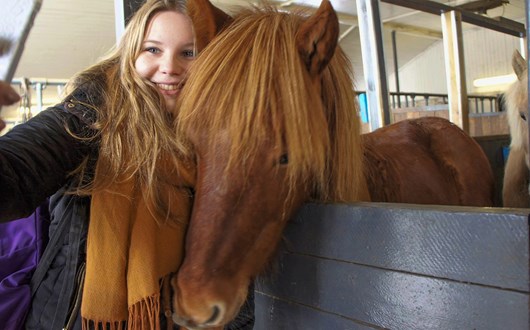
Riding Through the Lava on an Icelandic Horse
Horse riding in Iceland is something I have been dreaming about for a long time: This has to be on everyone’s bucket list – if you are not allergic to horses, of course!
What makes the Icelandic Viking horse unique? Is it its incredible soft gait, tölt? Or maybe its friendly demeanor? Is it that they grow up in open fields? Or that they have been purely bread since the Vikings brought them? Let's find out!
The Icelandic horse is a token of the Icelandic nation, its pride and joy. Our modern day steeds are ancestors of the first Viking horses that arrived with settlers between 860 and 935 CE. This horse has been with us through the mini ice ages, Viking battles, earthquakes, and volcanic eruptions. Today you’ll find these colorful creatures in meadows around the Ring Road, in the city, and on horse farms in Iceland.

Illustration of Icelandic horse farm
Read on to learn more about this breed’s unique features, gait, and where to see and ride them. Why is this horse so beloved in Iceland and abroad? What is so special about its gait? And where can you go horse riding in Iceland? Get the answers to all your questions about the Icelandic horse and discover fascinating facts you never knew!
Icelandic horses are unlike any other horses you may have been around. Not only in their gentle, fluffy appearance but also in their soft personalities and unusual walking abilities.

Known for their easy-going attitude, the temperament of Icelandic horses has made them popular around the world. Typically friendly and curious, they can also be stubborn and relentless. Some say it has to do with the freedom they experience as youngsters, with vast open grass fields to run around in and little contact with anyone except other horses. Others say it’s their closeness to the Viking people. Whatever the reason may be, the Icelandic horse is a part of Iceland you can’t miss when visiting.
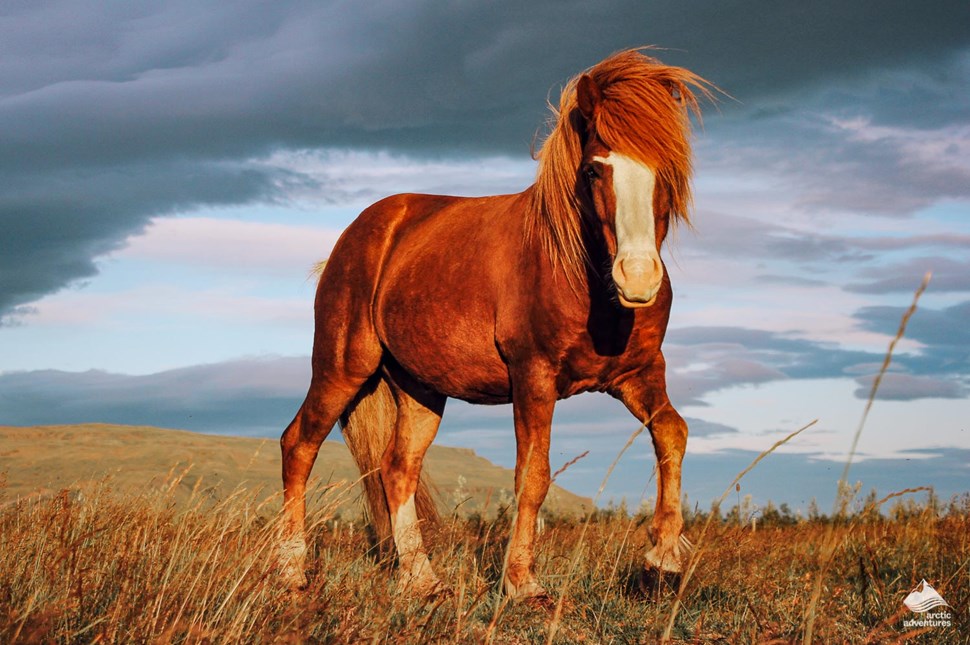
The Icelandic horse is most famous for its convenient size, strong build, and, of course, its fifth gait or tölt (way of walking). The fifth gait unique to the Icelandic horse allows a more stable and even pace, with 3 of the animal’s legs touching the ground at the same time. For riders, this means that the pace is comfortable while not being thrown around in their saddle.
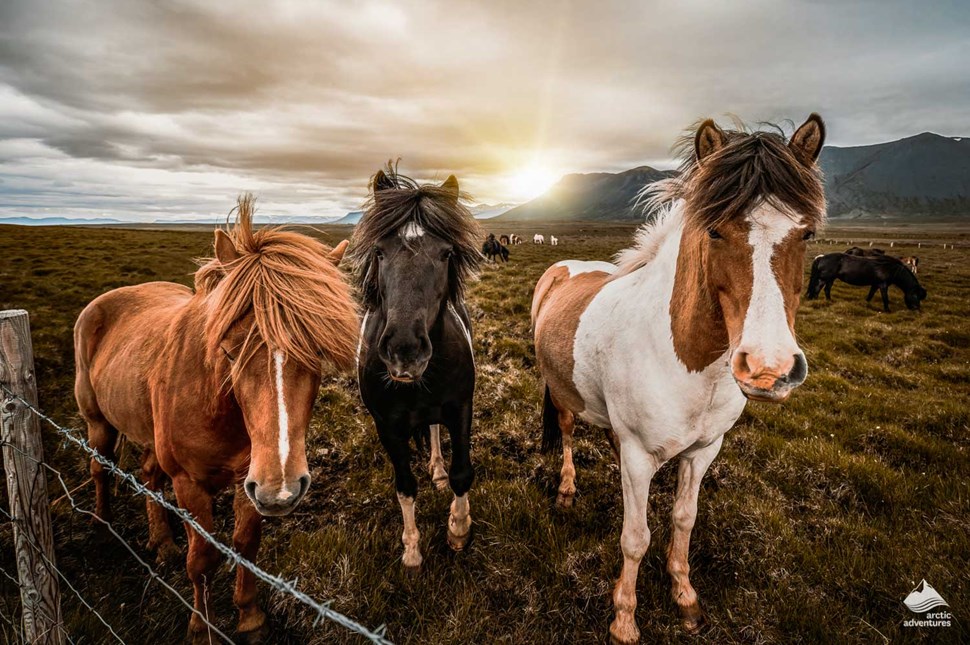
Icelandic horses in different colors
The beautiful Icelandic horse comes in over 40 colors and 100 various patterns. There are special words in the Icelandic language for each and every one! Sometimes the horse even changes color throughout its lifespan.
The most common colors are brúnn (brown) and rauður (red or chestnut), but the rarest color you can find is litföróttur. This roughly translates to “color travelers,” a very good description of this special color variation. If a horse has this color, it will change colors multiple times a year, often resulting in a splattered in-between color.

Icelandic horse with blue-colored eyes
Did you know? Icelandic horses can have light blue eyes. This is usually caused by either a white color covering the eye or the horse being two-colored. If a horse has blue eyes, it is “glaseygður” or “glass-eyed.”
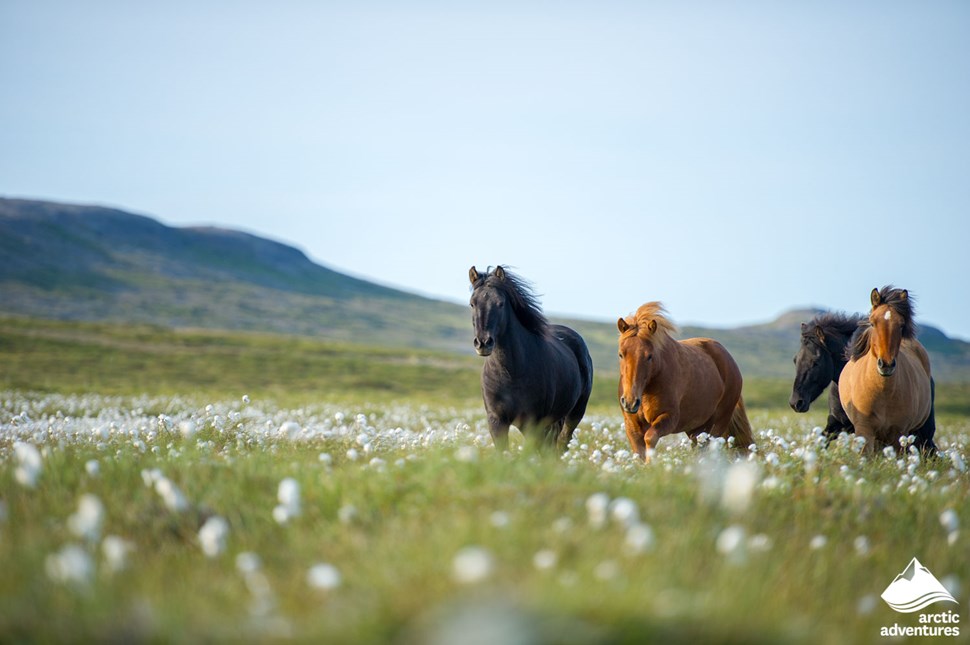
Icelandic horses in the field
The first horses were brought to Iceland by the Norse settlers between 860 and 935 AD. There are many theories as to why particular this breed was chosen. One of them is that because of the sturdy structure and relatively small size, these animals were easier to fit into boats and endure long overseas travel.
Following their arrival in Iceland, the Icelandic horse has remained relatively unchanged over time, however, it has adapted to the weather and terrain. For example, during cold winters they grow a thick coat, while in milder summers they shed this coat. Strong winds and harsh weather do not affect Icelandic horses, and they are strong enough to traverse tricky terrain and even glacial rivers.
As the Norse settlers imported the horses, they also imported the myths that came around them. Icelandic myths and legends state the long-lasting admiration for this breed. It was always considered not as a servant, but more as a friend and companion.
According to the first Icelandic book of laws, the theft of the horse was strictly punishable, and the offenders of the law were banished from the community to become outlaws. And if you're an outlaw in Iceland during the Viking Age, you could be legally (!) killed right on the spot without any explanation. Needless to say, there were very few who dared steal a horse during those times.

Animation of Odin riding an eight-legged horse
There was also a famous myth of Sleipnir, an eight-legged horse who belonged to Óðinn, the main god in Norse mythology. Sleipnir was also said to be the one behind the creation of Ásbyrgi Canyon in North Iceland. According to the legend, as the horse stepped one of his eight legs onto the ground, it left a horse-shaped canyon we can still see and admire today.

Pagan God Óðinn and his eight-leg horse
Eager to see an Icelandic horse for yourself? Join a black sand horseback riding tour and see them up close!
As mentioned above, the most unique thing about the Icelandic horse, when compared to other breeds, is their unique fifth gait. This means that along with the walk, trot, canter, and gallop they share with most other horse breeds, Icelandic horses have a special way of moving that is not seen anywhere else in the world.
The Icelandic horses can be split into two types of horses: the four-gaited (fjórgangs) and the five-gaited (fimmgangs). The five-gaited horse can ride skeið e. They are also considered more flexible and soft in their other gaits.
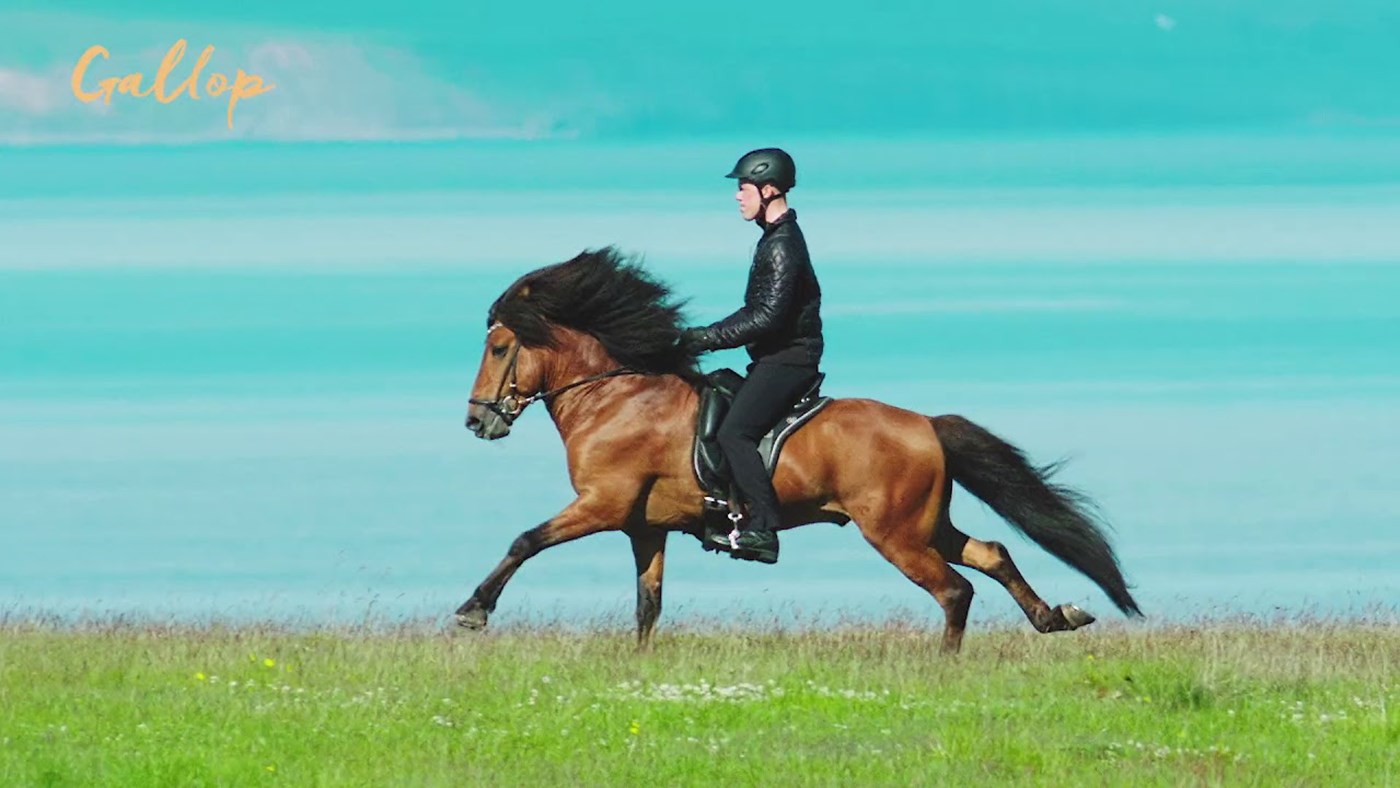
This gait can be observed during horse shows in Iceland. A walking pace, the more relaxed they are, the higher their grade when competing. It is a good rule to begin and end all horse riding tours with walking.
Brokk or trot is the most common gait around the world. It is often counted in two rhythms. When you are riding a horse in a trot, you will go up and down with each step. A good way to ride brokk is to step strongly into the stirrup and move with the horse.
Tölt is the additional gait that the Icelandic horse possesses. They are naturally able to tölt from birth. It is a four-beat lateral ambling gait, and its speed can vary a great deal. It is a smoother gait, and those horses who have all 5 gaits (fimmgangs) ride the tölt in an even softer manner.
There is a small difference between the canter and the gallop, but most would consider them to be the same. It is common amongst other horses in the world and can be ridden both fast and slow.
Another additional gait of the Icelandic horse is the pace or skeið, flugskeið, or flying pace. This is a particularly popular gait in racing as the horses can reach an incredible speed, up to 30 miles or 48 kilometers per hour. The gait skeið can only be performed by those horses who are five-gaited (fimmgangs).
During the flying pace, only two legs touch the ground at a time. This gait is not popular for regular riding as it is quite uncomfortable for the rider. However, it can be very entertaining and is sometimes used by experienced riders to help the horse stretch.
When participating in an Iceland horseback riding tour, you’ll be given clear instructions on how to interact with your horse companion for the duration of the tour. However, Icelandic horses spend a lot of the year simply grazing the Icelandic countryside. So when you’re driving Iceland’s main roads, you might spot wild-looking horses on your travels. Here are some tips to bear in mind when seeing horses by the side of roads in Iceland.
Picking the proper clothing is the most important way to prepare for your tour! Tours operate come rain, snow, or sunshine, so make sure you dress for the forecast. Iceland’s weather is often highly unpredictable, so layers are the best choice. If you plan on going horse riding in Iceland in winter, make sure to bring appropriate winter accessories. All tours include a riding helmet for safety and rubber riding boots. With the right gear, you will be all set for a horse riding adventure, no previous experience is required!
Due to their small stature, people often want to know whether Icelandic horses are considered to be ponies. The short answer is no, and Icelanders will be offended if you call them as such! Unlike ponies, Icelandic horses have impressive weight-carrying capabilities compared to their size. To protect the horses, the maximum weight limit for Icelandic horseback rides is 110 kg / 242 lbs.
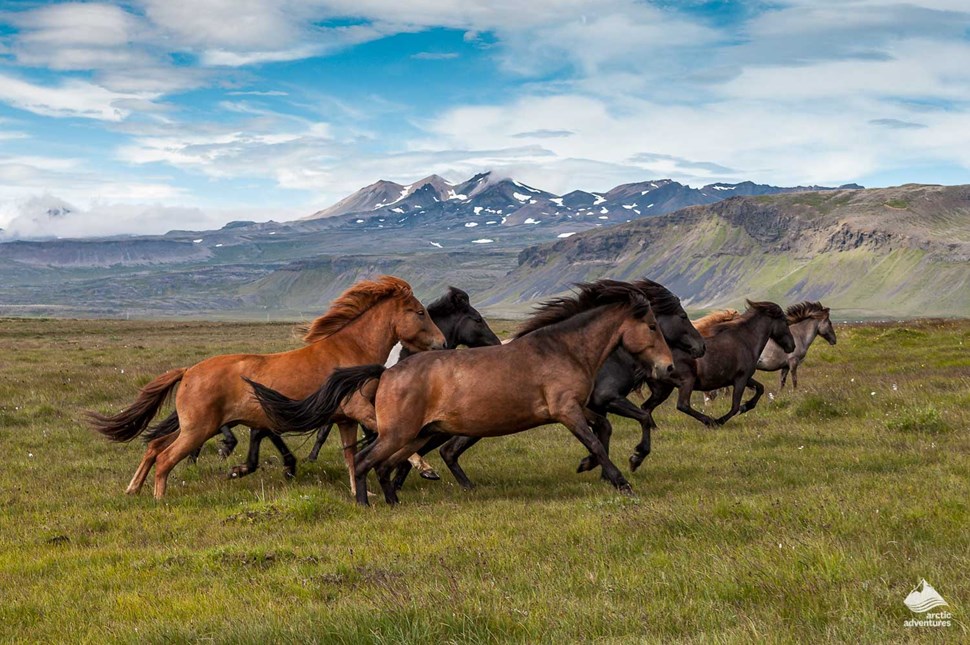
Group of wild horses running in Icelandic fields
There is, or at least used to be, a herd of about 100 wild horses in Iceland. For those who want to know where to find Icelandic horses, your best bet is a horseback riding tour or horse farm in Iceland.
Since the Icelandic parliament passed a law that bans the importation of horses, the only horses in Iceland are locally bred. Currently, there are about 80,000 Icelandic horses in Iceland, versus the human population of 364,260!
Icelandic horses are still used for traditional sheepherding, as well as for leisure, shows, and racing.
Although not as common as before, the answer to this question is yes. It’s important to stress that Icelanders do not eat the same horses they ride. Some horses are specially bred for their meat and those horses are never tamed or given a name.
While the average lifespan of the Icelandic horses is 20 to 30, this breed can live much longer. In Denmark, an Icelandic horse named Tulle was reported to live to the age of 57! Icelandic horses mature later than other horses and typically are typically not trained until age 4. It is not unusual to ride these horses well into their 20s.
Searching for where to ride horses in Iceland? Join a horseback riding tour and see for yourself what makes these animals so special!
Best Seller